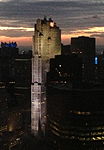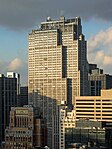Radio City Music Hall

Radio City Music Hall is an entertainment venue and theater at 1260 Avenue of the Americas, within Rockefeller Center, in the Midtown Manhattan neighborhood of New York City. Nicknamed "the Showplace of the Nation", it is the headquarters for the Rockettes, the precision dance company. Radio City Music Hall was designed by Edward Durell Stone and Donald Deskey in the Art Deco style. Radio City Music Hall was built on a plot of land that was originally intended for a Metropolitan Opera House, although plans for the opera house were canceled in 1929. It opened on December 27, 1932, as part of the construction of Rockefeller Center. The 5,960-seat Music Hall was the larger of two venues built for Rockefeller Center's "Radio City" section, the other being Center Theatre; the "Radio City" name later came to apply only to the Music Hall. It was largely successful until the 1970s, when declining patronage nearly drove the theater to bankruptcy. Radio City Music Hall was designated a New York City Landmark in May 1978, and it was restored and allowed to remain open. The theater was extensively renovated in 1999. Radio City's four-tiered auditorium was the world's largest when it opened. The theater also contains a variety of art. Although Radio City Music Hall was initially intended to host stage shows, within a year of its opening it was converted into a movie palace, hosting performances in a film-and-stage-spectacle format through the 1970s, and was the site of several movie premieres. It now primarily hosts concerts, including by leading pop and rock musicians, and live stage shows such as the Radio City Christmas Spectacular. The Music Hall has also hosted televised events including the Grammy Awards, the Tony Awards, the Daytime Emmy Awards, the MTV Video Music Awards, the NFL Draft, as well as graduation ceremonies for NYU and Barnard College.
Excerpt from the Wikipedia article Radio City Music Hall (License: CC BY-SA 3.0, Authors, Images).Radio City Music Hall
West 50th Street, New York Manhattan
Geographical coordinates (GPS) Address Website External links Nearby Places Show on map
Geographical coordinates (GPS)
| Latitude | Longitude |
|---|---|
| N 40.759722222222 ° | E -73.979166666667 ° |
Address
Radio City Music Hall
West 50th Street
10019 New York, Manhattan
New York, United States
Open on Google Maps








